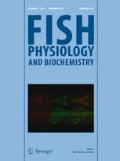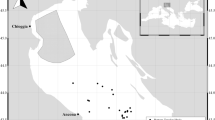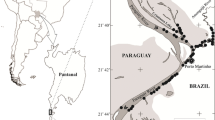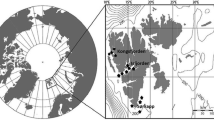Abstract
This study interrogated factors which affect the appearance of secondary sexual characteristics, namely, fin spinelets (rigid dimorphic structure empirically associated with male sexual maturity in characids), in Astyanax altiparanae. Many variables such as the season of the year and several biotic components, including organism length, sex, phase of maturation, and the presence of gonads, were investigated. These factors were then associated with the physiological development of fin spinelets. The development of this trait is related to reproductive strategies but demonstrates considerable population variability as it is found throughout the year in some species but only during specific periods in others. Seventy-five specimens obtained from spontaneous spawn of farmed fish were arbitrarily grouped into small-, medium-, and large-sized groups in both summer and winter. Gonadal histology was performed to confirm each animal’s sex and phase of maturation. Diaphanization of the fish was performed to visualize, count, and measure the fin spinelets. Finally, gonadectomization of some males was utilized to investigate the gonadal effect on the presence of fin spinelets. The present results show that the presence of fin spinelets is a secondary sexual characteristic of males which occurs independently of the season and is always present in males longer than 48 mm. However, in the summer, male specimens presented more rays with fin spinelets than during the winter. Furthermore, since fin spinelets were observed on immature males as well as spawning capable males, their presence cannot be directly associated with sexual maturity in male A. altiparanae, as previously supposed. Finally, gonadectomization resulted in an initial reduction in the length of fin spinelets. However, this trend was eventually normalized with time.




Similar content being viewed by others
References
Azevedo MA, Malabarba LR, Fialho CB (2000) Reproductive biology of the inseminating glandulocaudine Diapoma speculiferum Cope (Teleostei: Characidae). Copeia 2000:983–989
Baldisserotto B (2013) Fisiologia de peixes aplicada à piscicultura: UFSM Santa Maria
Bem JCD, Fontanetti CS, Senhorini JA, Parise-Maltempi PP (2012) Effectiveness of estradiol valerate on sex reversion in Astyanax altiparanae (Characiformes, Characidae). Braz Arch Biol Technol 55(2):283–290
Brown-Peterson NJ, Wyanski DM, Saborido-Rey F, Macewicz BJ, Lowerre-Barbieri SK (2011) A standardized terminology for describing reproductive development in fishes. Mar Coast Fish 3:52–70
Cassel M, Chehade C, Branco GS, Caneppele D, Romagosa E, Borella MI (2017) Ovarian development and the reproductive profile of Astyanax altiparanae (Teleostei, Characidae) over one year: applications in fish farming. Theriogenology 98:1–15
Chehade C, Cassel M, Borella MI (2015) Induced reproduction in a migratory teleost species by water level drawdown. Neotrop Ichthyol 13(1):205–212
Costa FG, Adolfi MC, Gomes CC, Jesus LWO, Batlouni SR, Borella MI (2014) Testes of Astyanax altiparanae: the Sertoli cell functions in a semicystic spermatogenesis. Micron 61:20–27
Dala-Corte RB, Fialho CB (2014) Reproductive tactics and development of sexually dimorphic structures in a stream-dwelling characid fish (Deuterodon stigmaturus) from Atlantic Forest. Environ Biol Fish 97(10):1119–1127
De Siqueira-Silva DH, Dos Santos-Silva AP, Bashiyo-Silva C, Rodrigues MS, Vicentini CA, Ninhaus-Silveira A, Veríssimo-Silveira R (2017) Testicular structure and seminal pathway in the yellowtail tetra Astyanax altiparanae (Characiforms: Characidae). Anat Histol Embryol 46(4):342–346
Do Nascimento NF, Pereira-Santos M, Piva LH, Manzini B, Fujimoto T, Senhorini JA, George SY, Nakaghi LSO (2017) Growth, fatty acid composition, and reproductive parameters of diploid and triploid yellowtail tetra Astyanax altiparanae. Aquaculture 471:163–171
Faria PMC, Crepaldi DV, Teixeira EA, Ribeiro LP, Souza AB, Carvalho DC, Melo DC, Saliba EOS (2007) Criação, manejo e reprodução do peixe Betta splendens (Regan 1910). Rev Bras Reprod Anim 30(3-4):134–149
Fonseca T, Costa-Pierce BA, Valenti WC (2017) Lambari aquaculture as a means for the sustainable development of rural communities in Brazil. Rev Fish Sci Aquac 25(4):316–330
Fujimoto T, Nishimura T, Goto-Kazeto R, Kawakami Y, Yamaha E, Arai K (2010) Sexual dimorphism of gonadal structure and gene expression in germ cell-deficient loach, a teleost fish. PNAS 107(40):17211–17216
Garutti V, Britski HA (2000) Descrição de espécie nova de Astyanax (Teleostei, Characidae) da bacia do alto rio Paraná e considerações sobre as demais espécies do gênero na bacia. Comn Mus Ciênc Tecnol 13:65–88
Gonçalves TK, Azevedo MA, Malabarba LR, Fialho CB (2005) Reproductive biology and development of sexually dimorphic structures in Aphyocharax anisitsi (Ostariophysi: Characidae). Neotrop Ichthyol 3(3):433–438
Harms CA, Lewbart GA (2000) Surgery in fish. Vet Clin North Am: Exot Anim Pract 3:759–774
IBGE (Instituto Brasileiro de Geografia e Estatística) (2017) Produção em Pecuária Municipal
Järvi T (1990) The effects of male dominance, secondary sexual characteristics and female mate choice on the mating success of male Atlantic salmon Salmo salar. Ethology 84(2):123–132
Jepsen D, Winemiller K, Taphorn D, Olarte DR (1999) Age structure and growth of peacock cichlids from rivers and reservoirs of Venezuela. J Fish Biol 55:433–450
Kelber D (1999) Tucunaré, uma paixão internacional: Arte & Ciência. ISBN: 8574730114
Lampert VR, Azevedo MA, Fialho CB (2004) Reproductive biology of Bryconamericus iheringii (Ostariophysi: Characidae) from rio Vacacaí, RS, Brazil. Neotrop Ichthyol 2(4):209–215
Machado-Evangelista M, Sussel FR, Romagosa E (2019) Environmental manipulation on Astyanax altiparanae out-of-season spawning. Lat Am J Aquat Res 47(2):292–302
Malabarba L, Weitzman S (2003) Descriptions of a new genus from southern Brazil, Uruguay and Argentina, with a discussion of a putative characid clade (Teleostei: Characiformes: Characidae). Comunicacoes do Museu de Ciencias e Tecnologia da PUCRS 16(1):67–151
Muñoz H, Van Damme P, Duponchelle F (2006) Breeding behaviour and distribution of the tucunaréCichla aff. monoculus in a clear water river of the Bolivian Amazon. J Fish Biol 69:1018–1030
Nozu R, Nakamura M (2020) Influence of prolonged cultivation on sexual characteristics of sterilized female tilapia, Oreochromis mossambicus, induced by high-temperature treatment. Aquaculture, 735245
Porto-Foresti F, Oliveira C, Foresti F, Castilho-Almeida RB (2001) Cultivo do Lambari: Uma espécie de pequeno porte e grandes possibilidades. Panor Aquic 11(67):15–19
Porto-Foresti F, Castilho-Almeida RB, Senhorini JA, Foresti F (2005) Biologia e criação do lambari-do-rabo-amarelo (Astyanax altiparanae). In: Baldisserto B, Gomes LC (eds) Espécies nativas para piscicultura no Brasil. UFSM, Santa Maria, pp 105–120
Potthoff T (1984). Clearing and staining techniques. Ontogeny and systematics of fishes, 35-37.
Rodrigues AM, Campos EC, dos Santos RA, Junior JM, da Camara JJC (1992) Tipo de desova e fecundidade do tambiú Astyanax bimaculatus Linnaeus, 1758 (Pisces, Characiformes, Characidae), na represa de Ibitinga, Estado de São Paulo, Brasil. Braz J Vet Res An Sci 29(2):309–315
Sato Y, Sampaio EV, Fenerich-Verani N, Verani JR (2006) Biologia reprodutiva e reprodução induzida de duas espécies de Characidae (Osteichthyes, Characiformes) da bacia do São Francisco, Minas Gerais, Brasil. Rev Bras Zool 23(1):267–273
Toft G, Baatrup E (2003) Altered sexual characteristics in guppies (Poecilia reticulata) exposed to 17β-estradiol and 4-tert-octylphenol during sexual development. Ecotox Environ Safe 56(2):228–237
Veríssimo-Silveira R, Gusmão-Pompiani P, Vicentini CA, Quagio-Grassiotto I (2006) Spermiogenesis and spermatozoa ulErastructure in Salminus and Brycon, two primitive genera in Characidae (Teleostei: Ostariophysi: Characiformes). Acta Zool 87(4):305–313
Yasui GS, Arias-Rodriguez L, Fujimoto T, Arai K (2009) A sperm cryopreservation protocol for the loach Misgurnus anguillicaudatus and its applicability for other related species. Anim Reprod Sci 116:335–345
Acknowledgments
The authors are grateful to the Sao Paulo Research Foundation (FAPESP) for the financial support of this research (2010/17429-1 and 2011/11664-1). We also acknowledge CEPTA/ICMBio for generously providing facilities and experimental fish.
Author information
Authors and Affiliations
Corresponding author
Ethics declarations
Conflict of interest
The authors declare that they have no conflict of interest.
Additional information
Publisher’s note
Springer Nature remains neutral with regard to jurisdictional claims in published maps and institutional affiliations.
Rights and permissions
About this article
Cite this article
Siqueira-Silva, D.H., Bertolini, R.M., Levy-Pereira, N. et al. Factors affecting secondary sex characteristics in the yellowtail tetra, Astyanax altiparanae. Fish Physiol Biochem 47, 737–746 (2021). https://doi.org/10.1007/s10695-020-00832-6
Received:
Accepted:
Published:
Issue Date:
DOI: https://doi.org/10.1007/s10695-020-00832-6




